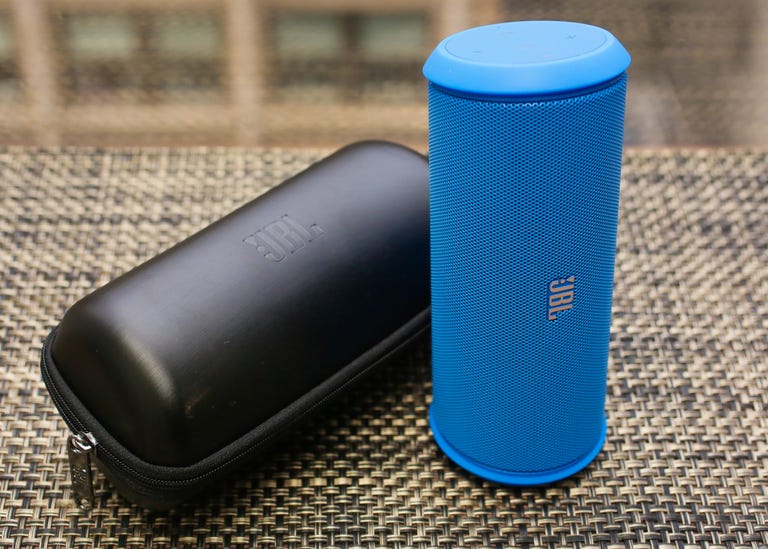 Why You Can Trust CNET
Why You Can Trust CNET JBL Flip 2 portable Bluetooth speaker review: Top portable speaker takes it up a notch
Although its battery life remains a weak point and its price has gone up a bit, the second-generation Flip is an improvement over the original and one of the best mini portable Bluetooth speakers currently available.
JBL's new Flip 2 may look very similar to company's original Flip wireless Bluetooth speaker, but it's got some key upgrades that make it a better speaker.
The Good
The Bad
The Bottom Line
On the performance end, JBL has improved the clarity of both the speaker and the speakerphone, which features something called SoundClear echo and noise cancellation technology. The speaker also has a slightly higher power rating (2x6 watts, 2x5 watts for the original Flip) and like the original, it plays impressively loud for its size. It's a tad heavier at .84 pounds (381g) versus 0.78 pound (354g) for the original, but still lightweight enough to easily carry around.
The other important change is to the way the Flip charges. With the original Flip, you had to charge it with a proprietary AC adapter. The new model charges via Micro-USB, which means that you can use a standard Micro-USB cable and plug it into a computer USB port or power adapter for charging.
JBL has also added NFC tap-to-pair technology for phones and tablets that the support the feature. However, I find this feature somewhat superfluous since the speaker will automatically connect with your mobile device (or PC) after you create an initial pairing. You just need to have Bluetooth enabled on your device, then turn the speaker on for automatic pairing.
The JBL Flip 2, which comes in a variety of colors, can be stood up vertically or laid down horizontally.
For those who aren't familiar with this speaker, it's called the Flip because you can stand it up vertically or lay it down horizontally. Like with the first Flip, I can't say I noticed a difference in sound quality but I listened to it more often oriented vertically than horizontally. It has a smaller footprint in this mode, and the physical buttons (power on/off, call end/answer, and volume) end up on top where they're a little easier to see and reach. It's worth noting that there's no pause/play button or transport controls (skip track forward/back) on the speaker itself. Most people won't mind, but some users like to have at least a pause/play button on the speaker.
In comparing the original to the new model, I did notice that the designers have traded a harder rubber finish for one that's soft to the touch and has a little more grip (this helps to keep the speaker from moving around when you crank the volume).
The other change involves the included carrying case. The previous version was a simple neoprene affair. The new "hard" case is a bit swankier and offers better protection. A Micro-USB cable and USB power adapter round out the included accessories.
Performance
The Flip was one of the better sounding Bluetooth speakers for its size and the Flip 2 takes things up a notch. It's not a big notch, but it's noticeable. The Flip 2 handles bass a little better at higher volumes and has a little bit smoother, cleaner sound. It can also play slightly louder, though you will encounter some harshness when you raise the volume above 70 percent (all these speakers do better at more modest volume levels).
The midrange is pretty forward, so vocals get accentuated, and there's a little treble push. I did throw some techno and rap at this little guy, and the bass comes off a little restrained (as you might expect), but the speaker does have more kick than many competing models. That said, the more expensive UE Boom delivers more bass.
The speaker charges via Micro-USB instead of requiring a separate AC adapter.
The Flip 2 beats some other popular Bluetooth speakers in this price class, including the UE Mini Boom and both the original Jambox and more expensive Mini Jambox. It also sounds fuller and more powerful than the smaller and less expensive Cambridge SoundWorks Oontz speakers, though like all these compact Bluetooth speakers that have their twin drivers so close together, there's really no stereo separation.
Speakerphone performance was good (callers' voices sounded very loud and they said they could hear me fine). No complaints there.
Alas, JBL hasn't improved the new model's battery life -- it's still rated at 5 hours, which is only so-so. You can do a little better by playing your music at quieter volume levels. And you'll fall short of 5 hours if you really crank your tunes.
If you're looking for better battery life, JBL also has the Charge, which currently retails for around $120 -- roughly the same price as the Flip 2. TDK Life on Record A33 Wireless Weatherproof speaker is also a good option, but it's significantly larger than the Flip 2.
A USB cable and power adapter are included along with a nice carrying case.
Conclusion
My only real gripe with the Flip 2 is its middling battery life. Otherwise, the tweaks to the design, slightly improved sound, and the ability charge via USB are nice upgrades over the original.
This speaker does cost a little more at $129.99 (the original Flip sells for less than $100), but relatively speaking, it remains a decent value, especially if you can pick it up at a slightly discounted price. The Flip 2 has its limitations, but the fact that it can play as big as it does (and sound fairly decent) for a small, highly portable speaker, makes it easy to recommend.


